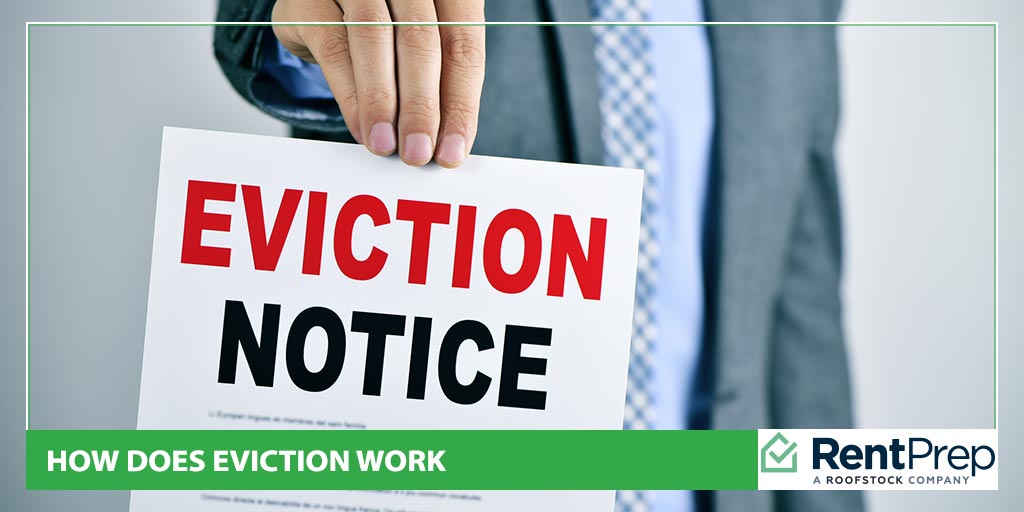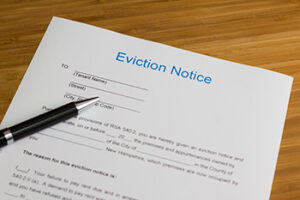
In an ideal world, every landlord would be fortunate with tenants who consistently pay rent on time, treat the property with care, and adhere to the lease agreement’s terms and conditions. However, as most landlords know all too well, reality doesn’t always align with this ideal. Despite rigorous screening, problematic tenants can still find their way into your rental property.
According to research conducted by the National Low Income Housing Coalition, approximately 6% of renter families in the United States face eviction each year, resulting in around 3.6 million eviction notices filed annually.
While it’s never a landlord’s desire to initiate eviction proceedings, there are times when it becomes a necessary course of action. Whether due to non-payment of rent, property damage, or unlawful activities on the premises, there are situations where eviction becomes the most viable solution.
With that in mind, we’ll take you through the eviction process for landlords step by step. By understanding how this process works, you’ll be better equipped to navigate the challenging situation should the need arise to evict a tenant.
Table Of Contents: How Does An Eviction Work?
What can you expect if you need to evict a tenant? Below is a step-by-step guide to what you should do and what may happen throughout the process.
- Step One: Establish Grounds For Eviction
- Step Two: Send A Notice To Vacate
- Step 3: File For Eviction
- Step 4: Attend The Court Hearing
- Step 5: Wait For Legal Eviction
- Step 6: Collect What You Are Owed
- How Long Does Eviction Take?
- FAQs – How Does Eviction Work For Landlords?
- Avoid Evictions With Tenant Screening
Step One: Establish Grounds For Eviction

The eviction process always begins with the landlord determining that the tenant is not abiding by the terms of the lease agreement and, therefore, deciding that the tenant either needs to change their behavior or vacate the property. But the landlord must have a valid reason for wanting to evict the tenant—it can’t just be a case of a clash of personalities.
While each state has its own landlord-tenant rules, legal grounds for evicting a tenant in New York City include nonpayment of rent, which can be missed, late or incomplete payments, or “holdover,” which means breaching the conditions of the lease, such as criminal activity, not abiding by health and safety standards, unapproved subleasing, other unauthorized tenants (including pets), or causing significant damage to the property.
New York City also allows landlords to include a general “nuisance” clause in lease agreements. This clause allows the landlord to pursue eviction for objectionable behavior, generally considered persistent and egregious conduct that threatens the neighboring tenants’ health, safety, or comfort.
Whatever the reason for the eviction, the landlord must be able to provide evidence of the behavior that caused them to file.
What if the tenant doesn’t have a lease? Learn how to evict someone without a lease here.
Step Two: Send A Notice To Vacate
If you have no problem with the tenant staying in the home, provided they change their behavior, you may give them a warning letter informing them of what needs to change so they can continue renting the property. This should be done in writing so you have evidence of the communication if the tenant does continue with the behavior and you choose to move forward with eviction.
To proceed with eviction, your next step is to issue the tenant a notice to vacate. This step can also give your tenant options. While it can be a notice to quit, which means the tenant must leave the property without an opportunity to remedy the problem, you can also send a “cure or quit” or “pay or quit” notice. In all cases, give them a time by which they must either remedy the situation or leave the property.
It’s important to note that the specific requirements for these notices, including the timeframes for compliance, can vary by state. For example, in New York, landlords must provide tenants with a five-day grace period for late payments and then a 14-day notice to pay or quit. For lease violations, the landlord can give the tenant ten days to change their behavior or leave the property.
The letter must be sent by registered mail as evidence that it was both sent and received. You can read our complete guide to how to write a notice to vacate letter here.
Step 3: File For Eviction
If the tenant does not comply with the notice to vacate and continues to live in the property without resolving the situation, it’s time to pursue formal eviction.
Start by going to your local courthouse and asking for the necessary paperwork to file for eviction. Bring with you proof that you have sent the tenant a notice to vacate and that they have not complied with the terms of that notice. Once you’ve completed the paperwork, the courthouse clerk will schedule a hearing date.
The court will send a summons to the tenant advising them of the court date. They must give the tenant at least 10 days’ notice before the court date, so you can expect to wait at least two weeks. However, the wait can be longer if there is a lengthy queue of cases.
Step 4: Attend The Court Hearing

You should attend the court hearing and bring all evidence you have that the tenant has broken the terms and conditions of their lease. Essential evidence will include the lease agreement, payment records, copies of communications, including the notice to vacate, and any evidence of unacceptable behavior at the property.
The court will review the documentation and decide whether the tenant can be evicted or if another course of action is necessary.
Tenants can defend their right not to be evicted or to have additional time to vacate. Common defenses tenants make include not receiving proper notice, the landlord charging illegal fees, or withholding rent because the landlord has not made certain repairs. Tenants can also file counterclaims against the landlord, for example, claiming the property is in poor condition or that they are being discriminated against under the Fair Housing Act.
As a landlord, you can be proactive and protect your business against these defenses by ensuring you’ve followed the process correctly and keeping meticulous records.
Filing for eviction and the associated court hearing do come with a cost. The exact amount varies by state and case, but you can expect to pay between $300 and $800.
Step 5: Wait For Legal Eviction
If the court approves the eviction, it will set a date by which the tenant must vacate the property. The length of time they are given to move out depends on local laws, but it’s usually between 48 hours and seven days and can be as long as 90 days. In New York, the Marshal, Sheriff, or Constable will deliver a Notice of Eviction to the tenant, giving them 14 days to move out.
If the tenant does not leave within the designated period, the landlord can take the court records to local law enforcement, who can remove the tenant from the property. As a landlord, you do not have the right to do this yourself. You cannot physically remove the tenant, change the locks, or use any kind of intimidation.
You can retake control of the property only after the tenant has either vacated or been lawfully removed. At this time, you’re free to change the locks if you believe it necessary.
Bear in mind that if the tenant has left any personal belongings behind, you cannot take possession of them. While you can dispose of anything deemed “garbage,” you must catalog and store any items of value that are left behind. Value can be subjective, and it’s best to err on the side of caution. This means that if there’s any doubt about whether an item might have value to the tenant, it’s safer to assume it does and handle it accordingly.
This personal property will need to be stored. Then, mail a notice to the former tenant informing them that you have the items and how they can collect them. How long you must give the tenant to do this depends on state laws. For example, many states, including California, Colorado, and Oklahoma, require 14 or 15 days, while others, such as Kansas and New Mexico, give 30 days. New York has no specified period.
Step 6: Collect What You Are Owed
Even once the tenant has been evicted and you’ve regained control of the property, they may still owe you money for rent or damages. Sometimes, this amount may be covered by the security deposit, but other times, what they owe will be more than the total deposit. You can pursue the former tenant for the balance due in small claims court. However, depending on how the eviction process went and the amount of the damages, some landlords choose not to take this action.
Bear in mind that if what a former tenant owes in rent or for damages is less than the security deposit, the deposit balance should be returned to them, even if they’ve been evicted. They may ask for an itemized list of how their security deposit was spent, and you should have that documentation ready.
How Long Does Eviction Take?
How long an eviction process can take depends on various factors, including local laws, the complexity of the case, and how quickly the courts can move. According to landlord forums, it can take anywhere from one month to a year for evictions to be completed, but most agree that in a simple case, it takes an average of three months from filing a notice to vacate to eviction. Cases tend to move more quickly if they relate to nonpayment of rent, while it can take months just to get a court date for holdover cases.
Because the eviction process can be challenging, some landlords consider alternative ways to remove tenants without eviction.
FAQs – How Does Eviction Work For Landlords?
Below are answers to some of the questions most frequently asked by landlords about the eviction process.
What are the valid reasons for evicting a tenant?
Acceptable reasons for evicting a tenant include failure to pay rent and violation of the terms of the lease, which could consist of damaging the property, having pets or subtenants when they are not allowed, or conducting illegal activities on the property. You can also pursue eviction if the lease ends and the tenant refuses to leave.
Can tenants be evicted immediately?
Generally, no. Tenants must be given the chance to rectify the issue if it can be rectified or find alternative housing. Immediate eviction without notice is typically only possible in extreme cases, such as if the tenant’s behavior poses an immediate safety risk.
Can a landlord physically remove a tenant or change the locks?
No, landlords are not permitted to take the law into their own hands by physically removing a tenant or blocking their access to the property. Acting under a court order, law enforcement officers are the only people who can do this.
What happens after a tenant is evicted?
Once a tenant has been legally evicted and vacated, the landlord can take control of the property. If the tenant has left anything behind, the landlord cannot immediately take possession of or sell those items but must handle them according to state law. If the tenant has damaged the property, the landlord can file a claim against them in civil court.
Avoid Evictions With Tenant Screening
The eviction process can be complex, costly, and take much longer than some landlords might expect. During the process, you’ll likely find you have limited control over your property while you aren’t making money from it. Therefore, you want to avoid the need to evict tenants as much as possible.
The best way to avoid eviction is to choose good tenants with the income to pay their rent and a history of paying rent on time and respecting the terms and conditions of rental contracts.
RentPrep tenant screening doesn’t just give you a credit report—you get a nationwide eviction report plus judgment, lien, and bankruptcy reports. Prices start at $21 per screening, which can be passed along to the potential tenant as part of a reasonable application fee. Find out more about RentPrep tenant screening here.
Note: RentPrep does not provide tax, legal, or accounting advice. This material has been prepared for informational purposes only and is not intended to provide, and should not be relied on for, tax, legal, or accounting advice. You should consult your own tax, legal, or accounting advisors.

